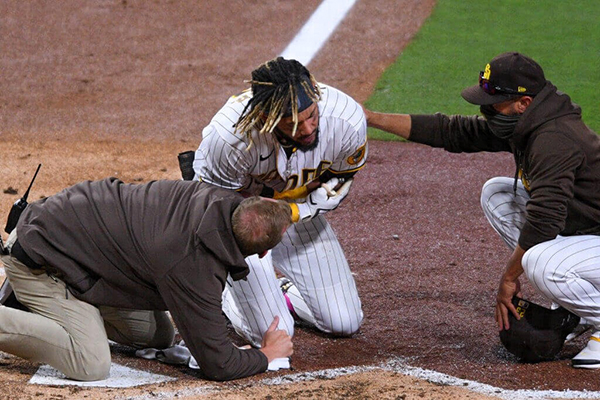Padres hope for the best with Fernando Tatis Jr.’s ‘non-surgical’ shoulder injury

The shoulder is the most flexible joint in the human body, enabling a wide range of motion, such as the mighty swing that produced a 465-foot home run at Petco Park on Sunday.
The shoulder, according to medical experts, is also the least secure joint in the human body. On Monday night, less than 28 hours after his tape-measure blast, Fernando Tatis Jr. whiffed at a curveball and collapsed in pain, having partially dislocated his left shoulder.
Now, much of the Padres’ fortunes appear to hinge on that shoulder. For now, the team appears to have avoided catastrophe, though employees and fans alike will remain on high alert.
Tatis, San Diego’s franchise shortstop, will not undergo shoulder surgery, the club announced Tuesday. General manager A.J. Preller said an MRI and other tests revealed “some slight labral tearing,” but termed the injury “non-surgical.” Tatis was placed on the injured list Tuesday night with the hope that he could return in as few as 10 days.
“This is not something that we feel like, long-term, we’re putting him at risk if he goes out there and continues playing this season,” Preller said.
Yet the GM also acknowledged a lingering threat.
“There’s always the chance that he can have another episode, another incident,” Preller said. “At that point in time, we’ll evaluate from there.”
Tatis’ latest instance of shoulder instability was not his first. The shortstop has dealt with what he and the Padres have described as occasional shoulder issues since his days in the minor leagues. Lately, the problem has become public and somewhat persistent.
In a March 13 spring training game, Tatis jarred his left shoulder on a headfirst slide into home plate. He would return to the lineup five days later. Then, on March 23, Tatis felt his left shoulder pinch while backhanding a ground ball. He would return to the lineup March 25.
On Monday, he exited another game in considerably more pain. Preller said the news was not all bad. Tatis’ shoulder popped back into place after he left the field. He later left the building in “pretty good spirits.” Preller said Tatis was feeling good enough Tuesday that he wanted to be in the lineup.
The Padres opted for the 10-day IL. Tatis will use the stint to continue his shoulder strengthening program. Meanwhile, the team will continue to talk with the shortstop about potential tweaks to his aggressive playing style.
“It’s digging into what’s going to keep him on the field for the whole season so we don’t have another incident like this again,” Preller said.
Preller said team doctors do not view surgery as inevitable. He allowed that the Padres will have to consider that option if Tatis’ shoulder dislocation problems become recurring. Dr. Brian Lee, an orthopedic surgeon at Cedars-Sinai Kerlan-Jobe Institute in Los Angeles, said medical studies involving people in Tatis’ age range have found heightened risk after a second episode.
“Once you have one (shoulder) dislocation, the risk to have continued instability is about 50 percent,” said Lee, who has not personally treated Tatis. “Once you have another dislocation episode, that risk goes up to over 90 percent. When somebody has recurrent instability in the shoulder or that ball has come out of the socket multiple times, we generally will recommend surgery to try to stabilize the shoulder.”
To those outside the Padres organization, the extent of Tatis’ shoulder instability remains unclear. Tatis said last week that he first encountered shoulder issues in rookie ball, but he downplayed them as something he has successfully managed throughout his career. Preller said test results Tuesday were “pretty consistent” with the findings from a physical and MRI in February when the Padres signed Tatis to the longest contract in major-league history.
Tatis, Preller added, did not experience significant shoulder problems in 2020, when he played in 59 of 60 regular-season games and finished fourth in National League MVP voting. After examining Tatis on Tuesday, Padres team doctors communicated their belief that the shortstop would not risk significant, long-term damage by continuing to play this season.
“They understand how important really all of our players are and understand this is their careers,” Preller said, “but especially a player like Fernando who’s going to be here for a long time. Obviously, we take that very seriously.”
Surgery, if Tatis and the Padres ever go that route, would come with its own risks. While arthroscopic labral repair is generally successful — Lee said patients typically return to full strength after four to six months — no operation is foolproof.
So, for now, the Padres will try to keep Tatis on the field as they pursue postseason glory. In the immediate future, they will lean on their depth. Ha-seong Kim, who started at shortstop Tuesday, figures to be the primary defensive replacement in Tatis’ absence. Other options include Jake Cronenworth, Jorge Mateo and Tucupita Marcano. None of them offer the five-tool impact that Tatis has supplied in his young career.
“Let’s be real. You’re not gonna replace him,” Padres manager Jayce Tingler said of Tatis. “Now, can a group of eight, nine, 10, 11 guys step their game up? … Like I said, you’re not gonna replace him, but we believe in our guys.”
The Padres also believe their current course of action is in Tatis’ best interest. Time will tell if this is true. Their fortunes might hinge on the outcome.
Source: The Athletic

